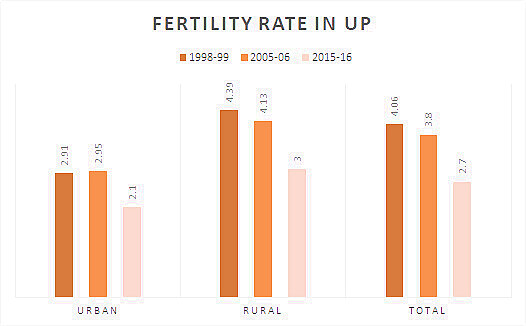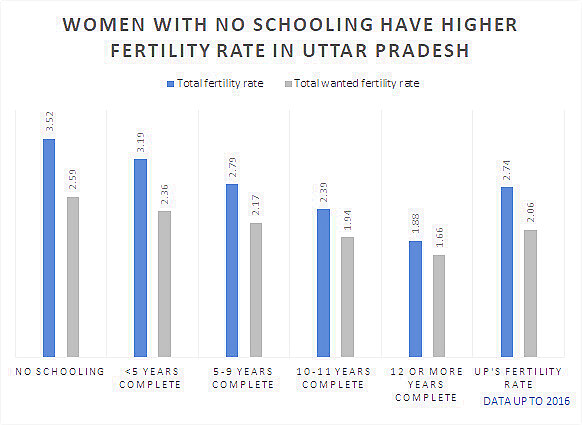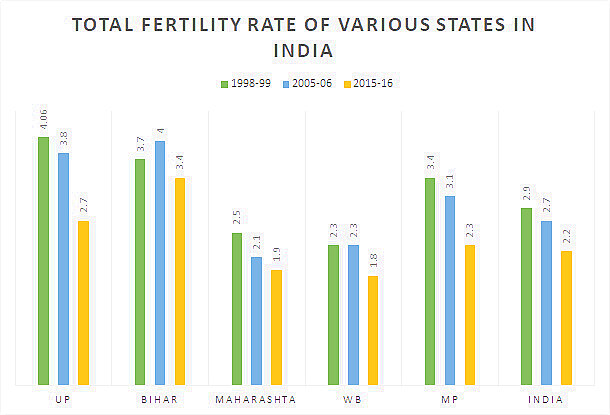
views
As the Yogi Adityanath government released a new policy to stabilise the population by bringing the total fertility rate (TFR) to 2.1 from its current value of 2.7 by 2026, official data analysed by CNN-News18 shows Uttar Pradesh has been witnessing a decline in the rate for the last several years.
The TFR – average number of children born to a woman in her reproductive years – had dropped from 4.06 (1999) to 2.7 (2016) in 17 years in UP, while that of India dropped by just 0.7 during the same period, official data shows.
As per Uttar Pradesh’s new population policy, the government aims to achieve a TFR of 2.1 — also the replacement level fertility (RLF) — by 2026. Among the targets is to bring the TFR to 1.9 by 2030, as well.
The RLF is the level at which a population exactly replaces itself from one generation to the next. So, for the population in a given area to remain stable, an overall total fertility rate of 2.1 is needed.
The TFR, as per the National Family Health Survey-4 (NFHS-4) (2015-16), was 2.1 for urban areas in Uttar Pradesh while for rural areas it was 3.0.
Between 2006 and 2016, the total fertility rate of the state had declined by 1.1 children per woman, the NFHS data analysed by CNN-News18 shows.

In 2005-06, the state’s total fertility rate was 3.8. While for urban areas it was 2.95, in rural areas it was 4.13.
In 1998-99, UP’s total fertility rate was 4.06. In the urban parts of the state, the TFR was 2.91 while for rural it was 4.39.
So far, four rounds of NFHS (1992–93, 1998–99, 2005–06, 2015–16) have been completed in India while the fifth round (2019-20) is still underway.
Women with no schooling have higher fertility rate in UP
The data also suggested that women with no schooling bore more children compared to those who were literate.

The TFR for women without any schooling stood at 3.5, as per the NFHS-4 (2015-16) while for women who had 12 or more years of schooling, it was 1.9. However, the TFR in illiterate women improved from 1999 to 2016.
As per the NFHS-2 (1998-99), the TFR in illiterate women was 4.54 while that in women with formal education till school level and above was 2.49.
Contraceptive prevalence rate increased in UP
Over the years, the contraceptive prevalence rate (CPR) among married women has increased in the state. As of 2016, it was 46 per cent — 1.5 times more since 1999, when it was just 27 per cent. The CPR in rural areas (42 per cent) is much less than that in urban areas (56 per cent).
The use of modern family planning methods (32 per cent), has increased slightly from its level in NFHS-3 (29 per cent). Notably, female sterilization as a contraceptive method has remained unchanged at 17 per cent in Uttar Pradesh between NFHS-3 and NFHS-4.
While the contraceptive prevalence for any method does not vary much by education, higher-educated women are more likely than less-educated women to use modern methods.
In contrast, women with no schooling are much more likely to be sterilized (22 per cent) than women with at least 12 years of schooling (7 per cent).
Also, women in the state are more likely to use contraception if they already have a son. As per the NFHS-4, among women with two children, 54 per cent with at least one son use a method of family planning, compared with only 34 per cent of women with two daughters.
In terms of districts, the CPR in Gautam Buddha Nagar is highest at 75 per cent. In districts like Ghaziabad, Jhansi, Meerut, Bareilly and Agra, the CPR is above 60 per cent. On the other hand, Balrampur has the lowest CPR at 2.7 per cent. In Gonda, Bahraich and Shravasti, it is less than 15 per cent.
Further, the report says that close to 38 per cent of men aged 15-49 in the state agree that contraception is women’s business and a man should not have to worry about it.
India’s fertility rate dropped by 0.7 children since 1999
The TFR of India was 2.9 in 1998-99, which dropped to 2.2 in 2015-16, NFHS data shows. Most of the states have reported a decline in the TFR over the years. As per NFHS-4, barring Bihar, all the most populous states had TFR rate below 3.0. While Bihar’s TFR in 2016 was 3.4, in 2020 it stood at 3.0. India’s TRF in 1951 was six, as per the government data.
At least 19 states have achieved the replacement level of fertility

As per the NFHS-5 (2019-20), the replacement level of fertility (2.1) has been achieved in 19 out of the 22 States/UTs under phase 1. Also, the TFR has declined since NFHS-4 in almost all the phase-1 states and UTs.
The 22 Phase-I States/UTs are: Andhra Pradesh, Assam, Bihar, Goa, Gujarat, Himachal Pradesh, Karnataka, Kerala, Maharashtra, Manipur, Meghalaya, Mizoram, Nagaland, Sikkim, Telangana, Tripura, West Bengal, Andaman Nicobar Island, Dadra and Nagar Haveli and Daman and Diu, Jammu & Kashmir, Ladakh and Lakshadweep.
Among these, only three states — Manipur (2.2), Meghalaya (2.9) and Bihar (3.0) — have TFR above replacement levels now.
The Overall Contraceptive Prevalence Rate (CPR) has increased substantially in most phase 1 States/UTs.
UP’s New Population Policy
CM Adityanath unveiled the new population policy on Sunday, saying increasing population is the root of major problems, including inequality prevailing in the society.
“Population control is the primary condition for the establishment of an advanced society. Let us, on this ‘World Population Day’, take a pledge to make ourselves and the society aware of the problems arising from the increasing population,” Adityanath tweeted. Through the new population policy 2021-2030, efforts will be made to increase the accessibility of contraceptive measures issued under the Family Planning Programme and provide a proper system for safe abortions.
The draft law has been prepared by the Uttar Pradesh Health Department based on the findings of the National Family Health Survey-4. One of the key points in the new policy is also to make comprehensive arrangements for the care of the elderly, apart from better management of education, health, and nutrition of adolescents between 11 and 19 years.
Read all the Latest News, Breaking News and Coronavirus News here.


















Comments
0 comment